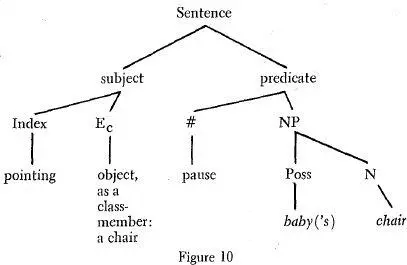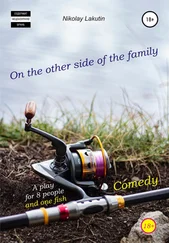Thus it is not a grammatical vagary, to be accounted for by a descriptive rule, that a child may say that a blue flower but never a that blue flower or blue a that flower (Brown and Bellugi). What Brown calls the “privileges peculiar to demonstrative pronouns” is in fact specified by the more general semiotic rule which requires the initial positioning of the index (I) , whether it be a demonstrative (there, that) or a behavioral item (looking, pointing). You can’t name something for someone without first pointing at it.
To summarize (1) and (2): Nearly the entire class of pivot-open constructions, plus the entire class of expanded utterances generated by the rules for “differentiation of the pivot class,” are not “phrases” to be accounted for by lists of descriptive generative rules. Rather are all such utterances specified by a general semiotic rule of sentence formation, in this case the naming sentence, in which both behavioral and syntactical components are ordered by presiding semiotic considerations.
(3) The open-open construction, which appears somewhere around the second birthday and accounts for the exponential explosion of language, is semiotically different from the naming sentence. It is in fact nothing more nor less than the adult NP-VP sentence without functors. It always comprises the pairing of contentives, often “nouns,” but also quality words and action words, e.g., baby wet, car go, man car (the man is in the car), etc.
Braine uses a juncture symbol (#) between the two words of an open-open construction to distinguish it from an otherwise similar utterance having a quite different meaning. Thus, again relying on the mother as the best of all interpreters:
baby#chair (The baby is in his chair)
baby chair (There is the baby’s chair)
The juncture symbol # is thus a semiotic mark which might be inserted between the “subject” S and “predicate” P of all sentences, whether naming sentences or NP-VP syntactical sentences. It marks a behavioral pause between what I am talking about and what I say about it.
Accordingly, it will be seen that the conventional syntactical “phrase marker” is in fact a special instance of a more general semiotic structure. Everyone is familiar with the NP-VP phrase-marker for a sentence like The baby is in his chair. A quite different but equally justifiable semiotic phrase-marker could be designed for the naming sentence baby chair, as diagrammed in Figure 10. There is only one lexical-syntactical item in this sentence, the NP baby chair. The other elements are behavioral (pointing, pause) or environmental (chair experienced as a class member).

There is only one lexical-syntactical item in this sentence, the NP baby chair. The other elements are behavioral (pointing, pause) or environmental (chair experienced as a class member).
Contrast the semiotic phrase-marker of the naming sentence baby chair with the conventional phrase-marker of the open-open construction baby#chair (the baby is in his chair), as in Figure 11.

To summarize 4.1: There are, semiotically speaking, two basic classes of linguistic sentences (we will say nothing here about nonlinguistic “sentences,” e.g., van Gogh’s painting “The Chair,” which assuredly uses a symbol to assert something about something else): the naming sentence and the NP-VP sentence.
Both kinds of sentence are acquired, understood, and uttered without the use of functors and other syntactical forms.
The addition of functors to child speech can be understood as the behaviorally necessary substitutes for a diminishing context. Thus a two-year-old child, sitting on his mother’s lap and looking with her out the window and saying boy lawnmower can be reliably understood to mean: The boy is pushing the lawnmower. But as context drops away, until at length the child is twelve and is reporting over the telephone to his mother about the performance of the gardener, the speaker needs his functors and must say Yes, the boy is still pushing the lawnmower.
5. As a genetic theory of language acquisition, we may hypothesize two basic stages, at each of which occurs a coupling of elements and in neither does it seem necessary to postulate a “deep syntactical structure” from which uttered sentences are derived by a series of transformations.
(1) The formation of semophones by the coupling of semological and phonological elements.
Much of the linguistic activity of the first two years of life goes toward the building up of an inventory, or lexicon, of semantically contentive words through which the world of experience is segmented, perceived, abstracted from, and named. So enduring and stable are these semological-phonological combinations that it seems appropriate to regard them as sound-meaning units, perhaps to be designated by some such term as semophone —the “phone” in this case signifying not a phone in the technical linguistic sense but rather the hierarchy of sound units: sound, phoneme, morpheme, word (Chafe).
As the neurophysiological correlate of such a coupling, one can only suppose that there come to be established stable functional interconnections between the visual and auditory cortexes. May we not at this point make bold to reach for the explanatory level of seventeenth-century physiology with its crude but accurate models of body functions — the heart is like a pump, the kidney is like a filter? Accordingly, may we not suggest that the LAD is like a coupler?
The semological and phonological components of the semophone are thoroughly interpenetrated. The resulting configuration is a much more stable and enduring entity than can be expressed by association psychology. Thus it is not so much the case that words like yellow, wet, glass, hop, Elmer, quick “ call up” such and such an association or have such and such a “connotation.” Rather is it the case that these sounds are interpenetrated and transformed by the classes of experience to which they refer. The contentive word in a sense contains the thing. Yellow becomes yellow.
(2) The formation of NP-VP sentences by the coupling of semophones.
Semophones are paired in the child’s open-open constructions to form the basic or contentive elements of the adult NP-VP sentence. One of the major tasks of an explanatory linguistic theory is to account for the practically unlimited number of new sentences which can be uttered and understood by a three or four-year-old child, following the input of limited and fragmentary data. If the basic component of the LAD is a coupler, it will be seen that this extraordinary generative capacity can be accounted for in two ways:
(1) The exponential increase in the number of open-open constructions which can be formed once an inventory of semophones is established. Thus, an inventory of n semophones (car, wet, Daddy, sock …) will yield an n2—n number of open-open sentences (car wet, car Daddy, Daddy wet, Daddy sock.. .). An inventory of 100 semophones will yield a possible 9,900 open-open sentences.
(2) A single open-open sentence is susceptible to as many sentential interpretations as context allows. Thus a child, sitting on his mother’s lap and looking out the window, who utters the sentence car Daddy, can be reliably understood by his mother to be saying Daddy is getting in the car, Daddy is washing the car, Daddy is kicking the car, depending on whether in fact Daddy is getting in the car, washing the car, kicking the car.
Читать дальше














